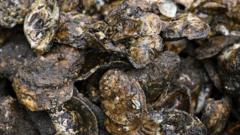Can an Artificial Reef Revive Wild Oysters?

Reviving Wild Oysters in Conwy Bay: A Step Towards Ecological Restoration
In an exciting development for marine biodiversity and local economies, the introduction of wild oysters into Conwy Bay is set to begin after nearly two years of delays caused by severe weather conditions. Bangor University, in collaboration with the Zoological Society of London, has received the green light to advance to the final stage of this critical project aimed at reseeding a 660-tonne artificial reef. This initiative not only symbolizes a restoration of natural habitats but also aims to revive an industry that has seen a significant decline over the years. Let's dive deep into the significance of this project, the historical context of wild oysters in Wales, and its broader implications for marine ecosystems and local communities.
The Historical Context of Oysters in Wales
Native oysters, once abundant in Welsh waters, have been integral to the coastal economy and culture. The Mumbles, also known as 'Oystermouth,' was once Wales' largest oyster fishery, supporting around 400 fishers across 188 boats. In the mid-1800s, Welsh oyster boats reported staggering numbers, landing up to 8,000 oysters daily, with some reports indicating as many as 15,000 to 20,000 oysters in optimal areas. These figures highlight not only the abundance of oysters but also their importance as a vital food source for coastal communities.
The Decline of Wild Oysters
Despite their historical significance, wild oysters in Wales have witnessed a dramatic decline due to several factors:
- Overfishing: Unsustainable harvesting practices have led to a drastic reduction in oyster populations.
- Changes in Water Quality: Pollution and habitat destruction have affected the health of marine environments where oysters thrive.
- Diseases: The spread of diseases has further impacted oyster populations, making recovery challenging.
This decline is not isolated to Wales; it reflects a broader trend observed across various regions in the UK and beyond, where native oyster stocks are diminishing due to similar challenges.
The Wild Oysters Project: A Collaborative Effort
The Wild Oysters Project aims to address the alarming decline of native oysters by reintroducing them into their natural habitats. This project is significant for several reasons:
- Ecological Restoration: By reseeding the artificial reef in Conwy Bay, the project aims to restore a crucial marine habitat that supports a wide range of marine life.
- Economic Benefits: Reviving the oyster population has the potential to boost local fisheries and enhance the economic viability of coastal communities.
- Educational Value: The project serves as a case study for marine conservation, educating communities about the importance of sustainable practices.
Project Implementation and Next Steps
Harbourmaster Matthew Forbes recently announced that 76 bags of oysters are ready for distribution, marking a significant milestone for the project. The artificial reef, initially found to be above the marine licensed permitted height, has been adjusted in response to the impacts of storms over the past couple of years. With Natural Resources Wales approving the project to move forward, the first distribution run is set to take place soon, moving the project closer to its goal of ecological restoration.
Benefits of Reintroducing Wild Oysters
The reintroduction of wild oysters into Conwy Bay holds numerous benefits for the environment and local communities:
1. Enhancing Marine Biodiversity
Oysters play a crucial role in marine ecosystems as filter feeders. They help improve water quality by filtering out pollutants and excess nutrients, thereby creating a healthier environment for other marine life. Their presence can lead to increased biodiversity, fostering a more resilient ecosystem.
2. Supporting Local Fisheries
Reviving oyster populations can significantly benefit local fisheries. Oysters are not just a food source; they also create habitats for various marine species, promoting biodiversity and enhancing fish stocks. A resurgence in oyster populations can lead to increased catches for local fishers and contribute to the sustainability of the fishing industry.
3. Economic Growth
The economic impact of a successful oyster reintroduction project could be substantial. By revitalizing the oyster fishery, local communities can benefit from increased job opportunities, tourism, and related industries. The Mumbles fishery, for instance, once supported hundreds of jobs; restoring the oyster population could revive this vital economic engine.
4. Community Engagement and Education
Community involvement in conservation efforts fosters a sense of stewardship among residents. The Wild Oysters Project provides an opportunity for local communities to engage in marine conservation, learn about sustainable practices, and appreciate the importance of preserving natural resources for future generations.
Success Stories from Other Regions
The efforts to reintroduce wild oysters in Wales are part of a broader trend seen across various regions of the UK and beyond. Similar initiatives have demonstrated the potential for successful oyster restoration:
1. East Yorkshire Coast
A wildlife project on the East Yorkshire coast is currently testing new breeding techniques to reintroduce 500,000 native European flat oysters over the next five years. This project aims to restore the ecological balance in the region and enhance the local marine environment.
2. Thames River Restoration
Last year, discussions emerged regarding the potential return of oysters to the Thames as part of a broader effort to clean London's rivers. This initiative aims to improve water quality and restore marine ecosystems in urban environments, showcasing how oysters can contribute to environmental health even in heavily populated areas.
The Role of Community and Stakeholders
For projects like the Wild Oysters Project to succeed, collaboration among various stakeholders is essential. These include:
- Local Governments: Support from local councils, such as Conwy Council, is vital for ensuring that necessary permissions and resources are allocated.
- Environmental Organizations: Partnerships with organizations like the Zoological Society of London facilitate research and development efforts aimed at restoring marine habitats.
- Community Members: Engagement from local residents can foster a sense of ownership and responsibility towards marine conservation efforts.
Challenges Ahead: Navigating Future Obstacles
While the future looks promising for the reintroduction of wild oysters in Conwy Bay, several challenges must be addressed:
1. Environmental Changes
Climate change and its associated impacts, such as rising sea temperatures and changing salinity levels, pose significant challenges to marine life. Ensuring that the reintroduced oyster populations can withstand these changes is crucial for their long-term survival.
2. Monitoring and Research
Ongoing research and monitoring will be essential to assess the health of the newly introduced oyster populations. Understanding their growth patterns, reproductive success, and interactions with other marine species will inform future conservation efforts.
3. Continued Community Support
Sustaining community interest and support for the project will be vital. Educational programs and outreach initiatives can help keep local residents engaged and informed about the importance of marine conservation.
Conclusion: A Bright Future for Wild Oysters in Conwy Bay
The reintroduction of wild oysters into Conwy Bay represents a significant step towards ecological restoration and economic revitalization for the region. By restoring this vital species, stakeholders aim to enhance marine biodiversity, support local fisheries, and engage communities in conservation efforts. As we look forward to the first distribution run of oysters, the potential for a thriving oyster population in Conwy Bay is an inspiring reminder of the resilience of nature and the importance of sustainable practices. Will we see a resurgence of vibrant oyster beds in Welsh waters, reminiscent of their historical abundance? Only time will tell, but the commitment to this project is a promising sign for the future.
FAQs
What is the purpose of the Wild Oysters Project in Conwy Bay?
The Wild Oysters Project aims to reintroduce native oysters into Conwy Bay to restore marine biodiversity, improve water quality, and support local fisheries and economies.
How do wild oysters contribute to the marine ecosystem?
Wild oysters act as filter feeders, improving water quality by filtering out pollutants and excess nutrients. They also provide habitats for various marine species, enhancing biodiversity.
What challenges does the project face?
Challenges include climate change impacts, the need for ongoing research and monitoring, and ensuring continued community support and engagement in conservation efforts.
As we witness the reintroduction of wild oysters in Conwy Bay, the question remains: Can this effort pave the way for a sustainable future for marine life and local communities alike? #WildOysters #MarineConservation #SustainableFishing
Published: 2025-06-16 12:15:12 | Category: wales



